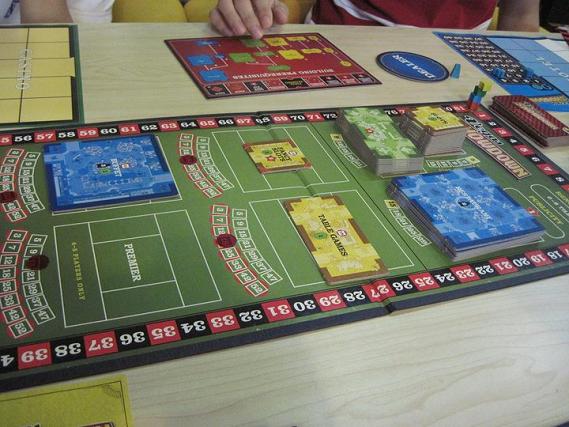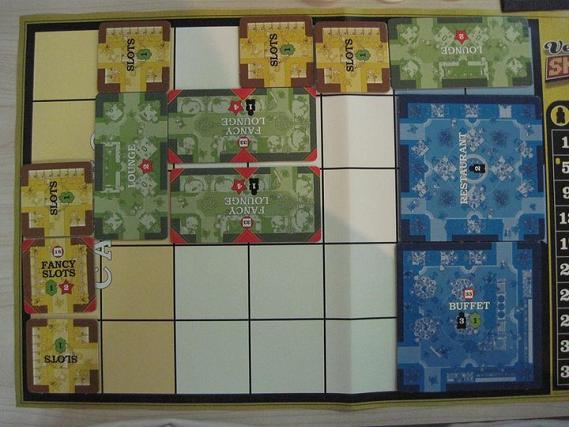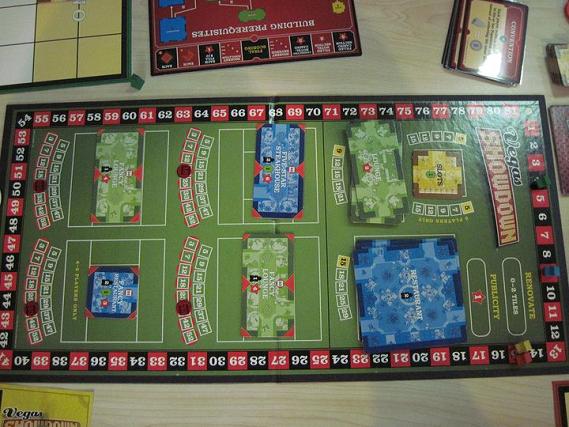
Sean calls this the third in our series of recent plays of out of print Avalon Hill games. Vegas Showdown is also the least Ameritrashy and most Eurofied of the three games, so it’s no surprise that both my wife and myself liked this one the most. This one’s theme is about building a casino and I was curious if it had any gambling mechanics. I had been wondering if there were any boardgames that let you stake some variable amount of resources on a certain outcome and then reward you if your bet turned out to be right.
As it happens, Vegas Showdown doesn’t have anything like that at all and overall feels very much like a Euro game. It’s mostly a bidding game as the object is to buy tile pieces that you lay on a mat to build your own integrated casino and hotel resort. The rest of the components are fine and we especially liked how each of the different types of tiles had unique art showing what’s going on in that room, but the mat itself is just a flimsy sheet of glossy paper. As we needed to put tiny tokens on top of it to track various things, using paper instead of thick cardboard made it easy to knock them out of place when you’re reaching for stuff or just adjusting the tiles on your mat.
Just like a regular Euro, each player is out to score as many points as possible. The most straightforward way is buying one of the room tiles with a Victory Point value and adding it to your complex. This is actually easier said than done as there are restrictions on how you can place rooms on your mat. The mat itself is divided into a casino area on one end and a hotel area on the other end. In between is a neutral area. The tiles themselves are either hotel, casino or neutral. Neutral tiles can go anywhere, while casino tiles can’t be placed in the hotel area and hotel tiles can’t be placed in the casino area. Finally, each tile comes with a certain number of entrances and tiles can only be placed such that the entrances line up so that it’s possible to walk from the main entrance to the tile.

The stronger tiles also possess prerequisites, meaning that they can’t be placed unless you already have the basic version as part of your resort. For example, you can only place a “Fancy Slots” tile after your casino already has a “Slots” room. The most onerous tiles actually require you to place them adjacent to specific other named tiles, rather than just fulfilling the requirement of being able to reach it from an entrance. All this matters because you get significant bonus points for completely filling the spaces in your casino or hotel zones and for connecting the two zones so that a patron can walk from one end to the other.
In addition to points, building rooms gets you more Income and People, and the cash you get at the beginning of every turn equals to the lesser of the two values, so players need to find a good balance between the two. Bonus points are also awarded at the end of the game for having the most Income or People. Building tiles are acquired by winning bids for them. Each turn, one of each of the basic rooms, namely the Restaurant, Slots and Lounge is available for purchase. The upgraded rooms are placed on the spaces below that and which size of tile to draw depends on the event cards drawn. In turn order, players then place their markers below the tile that they wish to buy on the price that they’re willing to pay, keeping in mind that there is a minimum starting price for the upgraded versions. This price goes down each turn if no one buys that tile. Anyone who is outbidded can bid higher or move away to buy something else.
This means that players can buy and place only one room each turn. Players who don’t wish to buy anything can place their marker on the Publicity space for immediate points or place it on the Renovation space which allows them to move around up to two of their rooms. That’s pretty much all there is to the rules. The last part is that the event cards add some random effects, giving bonuses to players who have certain rooms, preventing anyone from buying a particular room tile for one turn or in our game, giving all players extra money equal to how many People they have, which made a pretty big difference in our game. The game ends when an event card is drawn that calls for a tile of a certain size to be refilled onto the board but that stack has run out.

As Shan pointed out, this game is a bit like the Princes of Florence, another game that we enjoyed greatly, in which you’re trying to best fit tiles of various sizes inside a fixed space. While Vegas Showdown has room tiles that come in one of three shapes, this is more than made up for by the layout of the entrances available and the room placement rules. All of us had a fiendish time trying to make our tiles fit in such a way as to maximize our points, especially since the better the room, the less doors it has, making it very hard to place indeed. The prerequisites also force you to agonize over whether or not to buy something you can’t place yet or risk seeing it being snatched away. Plus because the bidding works in fixed increments, you might want to begin bidding on something other than the minimum value to discourage others from trying to outbid you.
Sean commented that just like many Euros, the theme of Vegas Showdown doesn’t have much to do with its rules. While this is true, I still felt that the experience of trying to outdo your fellow players in trying to build the best and flashiest resort to be quite realistic and intuitive. This is unlike many Euros in which the scoring systems seem completely arbitrary and disconnected with what’s going on. I do agree that the event cards are the most Ameritrashy part of the game and make too much of a difference. Their effects are just too dramatic. Maybe a variant could be possible in which you do without them entirely and instead have players decide which size of room tile gets refilled onto the board with the lowest scoring players going first? You’d need to rejig the Victory Point track to reflect all earned bonuses the moment a player qualifies for them if you do this however to be fair, instead of at the end of the game.
All in all, despite being a game that leans towards the light side, Vegas Showdown was a lot of fun for me and one that I’m sorely tempted to buy were it still available as a mass market product. I guess this just clinches my liking for games that have you using tiles or other components to build something of your own on a mat. There’s just something so satisfying about watching your blank mat grow into something substantial over the course of a game. From the photos here, I just realized that I managed to get second place in our game despite not getting any of the top tier rooms at all. Now I feel like building a swanky casino with all of the cool toys I missed out on.
Leave a Reply